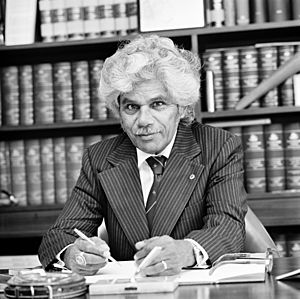Neville Bonner facts for kids
Quick facts for kids
Neville Bonner
|
|
|---|---|

Bonner in 1979
|
|
| Senator for Queensland | |
| In office 20 August 1971 – 4 February 1983 |
|
| Preceded by | Dame Annabelle Rankin |
| Succeeded by | Ron Boswell |
| Personal details | |
| Born |
Neville Thomas Bonner
28 March 1922 Ukerebagh Island, New South Wales, Australia |
| Died | 5 February 1999 (aged 76) Ipswich, Queensland, Australia |
| Political party |
|
| Spouses |
Mona Bonner
(m. 1943; died 1969)Heather Ryan
(m. 1972) |
| Children | 5 boys |
| Occupation | Federal Senator |
Neville Thomas Bonner was an important Australian politician. He was the first Aboriginal Australian to become a member of the Parliament of Australia. This is Australia's main law-making body.
Neville Bonner was first chosen by the Parliament of Queensland to fill a spot in the Australian Senate. Later, he became the first Indigenous Australian to be voted into Parliament by the people. He was an elder from the Jagera people.
Contents
Neville Bonner's Early Life
Neville Bonner was born on 28 March 1922. He was born on Ukerebagh Island, a small island in New South Wales. This island is close to the border with Queensland.
His mother, Julia Bell, was an Indigenous Australian. His father, Henry Kenneth Bonner, was an English immigrant. Neville's father left his mother before he was born.
His family moved to Ukerebagh Island. Later, they moved near Lismore, New South Wales. They lived close to Neville's grandparents.
Neville's mother passed away in July 1932 when he was ten. His grandmother then became his main caregiver. In 1935, he finished his only year of school. This was at Beaudesert State Rural School.
After school, Neville worked many jobs. He was a ring barker (removing tree bark), a cane cutter (cutting sugar cane), and a stockman (looking after farm animals). In 1946, he moved to Palm Island, Queensland. There, he became an Assistant Settlement Overseer.
Neville Bonner's Political Journey
In 1960, Neville lived in Ipswich, Queensland. He joined the board of a group called the One People of Australia League (OPAL). This group worked for Indigenous rights. He became its Queensland president in 1970.
He joined the Liberal Party in 1967. In 1971, a Senator named Annabelle Rankin resigned. Neville Bonner was chosen to take her place. This made him the first Indigenous Australian in the Australian Parliament.
He was then voted into Parliament by the people four times. These elections were in 1972, 1974, 1975, and 1980.
While in the Senate, he worked on many committees. He often voted against his own party's ideas. This is called "crossing the floor." It showed he was independent in his thinking. This was one reason his political career ended.
In 1983, he was not chosen by the Liberal Party to run again. So, he ran as an independent candidate. He almost won! After this, he was appointed to the board of the Australian Broadcasting Corporation.
Neville Bonner was special because he was an Indigenous activist who was also a political conservative. He often said he was not just a "token" member of the Liberal Party. In 1981, he was the only government member to oppose a bill. This bill would have allowed drilling in the Great Barrier Reef.
In 1979, Neville Bonner was named Australian of the Year. He shared this award with naturalist Harry Butler. In 1984, he received the Order of Australia award. From 1992 to 1996, he was part of the Griffith University Council. The university gave him an honorary doctorate in 1993.
Neville Bonner passed away in Ipswich in 1999. He was 76 years old.
His grand niece, Joanna Lindgren, also became an Aboriginal Senator for Queensland. She served from 2015 to 2016.
Honours After His Life
Many things have been named after Neville Bonner to honour him.
The Neville Bonner Memorial Scholarship was started in 2000. It helps Indigenous Australians study Political Science at university. It is a very important scholarship.
The federal voting area of Bonner in Queensland was named after him in 2004. A rugby league oval in Ipswich is now called the Neville Bonner Sporting Complex.
The suburb of Bonner in Canberra also carries his name. The main office for the Queensland Department of Communities in Brisbane was called the Neville Bonner Building. A hostel in Rockhampton for Indigenous people is named the Neville Bonner Hostel.
A new bridge in Brisbane, the Neville Bonner Bridge, is planned to open in 2022.
Personal Life and Boomerangs
Neville Bonner married Mona Banfield in 1943. They had five sons and fostered three daughters. Mona Bonner passed away in 1969. Neville then married Heather Ryan in 1972.
Neville's grandfather taught him how to make boomerangs. In 1966, he started a boomerang business called Bonnerang. His family helped him. He made boomerangs by hand from black wattle tree roots. He refused to use fake materials.
His company made up to 450 boomerangs each week. But it closed after a year because there wasn't enough wood. After he became a politician, Neville showed how to throw boomerangs at Parliament House.
In his first speech in Parliament, he asked for the special designs of boomerangs to be protected for Indigenous people. This was because other people were making cheap, fake boomerangs. One of his boomerangs is now kept at the Museum of Australian Democracy.
See also
Images for kids


